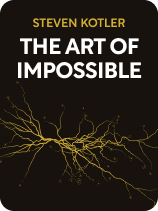

This article is an excerpt from the Shortform book guide to "The Art of Impossible" by Steven Kotler. Shortform has the world's best summaries and analyses of books you should be reading.
Like this article? Sign up for a free trial here .
What does Steven Kotler’s The Art of Impossible say about achieving dream goals? Which steps are most important for making your dreams a reality?
Author Steven Kotler wrote his bestselling book, The Art of Impossible, after extensively researching how the nervous system and brain work to impact motivation. Through his research, Kotler identified habits that the world’s top performers use to achieve seemingly impossible goals.
Keep reading to learn Kotler’s secret to success, according to advice from The Art of Impossible.
The Art of Impossible: Steven Kotler’s Secret to Success
How is it that some people can achieve seemingly impossible feats? And how can we emulate them to make our dreams more attainable? Bestselling author, award-winning journalist, and peak performance expert Steven Kotler wrote The Art of Impossible by drawing on extensive neurobiological research to demystify the path to breakthrough success. He presents a step-by-step process for developing peak performance habits that will help you achieve your most ambitious goals.
In The Art of Impossible, Steven Kotler argues that the real secret to maintaining peak performance is to generate all six reward neurochemicals at one time. When combined, the reward neurochemicals produce a potent mix of pleasurable advantages that boost motivation, optimize performance, and enhance overall well-being. The only way to generate and benefit from all six reward neurochemicals is to regularly work in a state of flow—we’ll refer to this state as “full engagement” throughout the rest of the guide.
How to Achieve Kotler’s “Full Engagement”
We’ll now explore Steven Kotler’s step-by-step process from The Art of Impossible for priming your neurochemicals to help you practice “full engagement.” Regularly achieving this state of mind will help you cultivate peak performance habits that will make your seemingly impossible goals more attainable.
Step #1: Identify Your Interests
The first step toward cultivating intrinsic motivation involves exploring your interests to discover what intrinsically motivates you. According to The Art of Impossible, Steven Kotler says focusing your attention on your interests produces enough dopamine to initiate the feeling of motivation.
- Write down 25 things that you’re interested in learning more about. Narrow down your interests so that they’re as specific as possible. For example, instead of “gardening,” write: “the specific conditions required to grow cherry tomatoes all year round.” Instead of “solar energy,” write: “the process that allows solar panels to convert energy into usable power.”
Step #2: Connect Your Interests Together
Once you’ve identified your interests, find ways to link your interests together. According to Kotler, this helps your brain form connections between different ideas, which generates more dopamine and increases your motivation.
- Look for areas where two or more of your interests share common ground or complement each other. Then link them together to create a new area of interest. For example, link “the specific conditions required to grow cherry tomatoes all year round” with “the process that allows solar panels to convert energy into usable power” to create this combined interest: “the possibility of using solar power to grow produce all year round.”
Step #3: Explore Your New Areas of Interest
Once you’ve created connections between your interests, set aside time each day to learn more about your new areas of interest. Steven Kotler argues in The Art of Impossible that absorbing new information every day feeds your brain a continual stream of information while giving it time to naturally make connections between what you already know and what you’re learning. This generates more dopamine, which further increases your motivation to learn more.
- Spend 30 minutes every day learning more about your new areas of interest. Use a variety of media. For example, to explore “the possibility of using solar power to grow produce all year round,” you might listen to a podcast about sustainable living, read an article about how solar batteries work, or take notes from a book about indoor gardening.
Step #4: Seek Out Social Reinforcement
As you work through the process of exploring your interests, share what you’re learning with other people. According to Kotler, including other people in your exploration garners positive feedback and social support. This positive attention generates a combination of dopamine and oxytocin. This makes your progress feel more meaningful and boosts your motivation to continue learning more about your topics.
Step #5: Define Your Seemingly Impossible Goal
Defining your dream goal is the final step for achieving full engagement, according to advice from The Art of Impossible. Steven Kotler believes the more you learn about and share your interests, the easier you’ll find it to define your seemingly impossible goal—by exploring how your interests might solve a global problem. According to Kotler, believing that you’re involved in something that has the potential to make a massive positive impact on the world shifts your attitude from “exploring something interesting” to “working toward something important.” This attitude shift transforms your exploratory work into a meaningful purpose that generates even more reward neurochemicals—resulting in decreased stress levels and increased levels of motivation, productivity, resiliency, and focus. Consequently, you find it easier to sustain long-term momentum and achieve your goal.

———End of Preview———
Like what you just read? Read the rest of the world's best book summary and analysis of Steven Kotler's "The Art of Impossible" at Shortform .
Here's what you'll find in our full The Art of Impossible summary :
- A look at how some people can achieve seemingly impossible feats
- How to make your dreams more attainable
- A step-by-step process for developing peak performance habits






